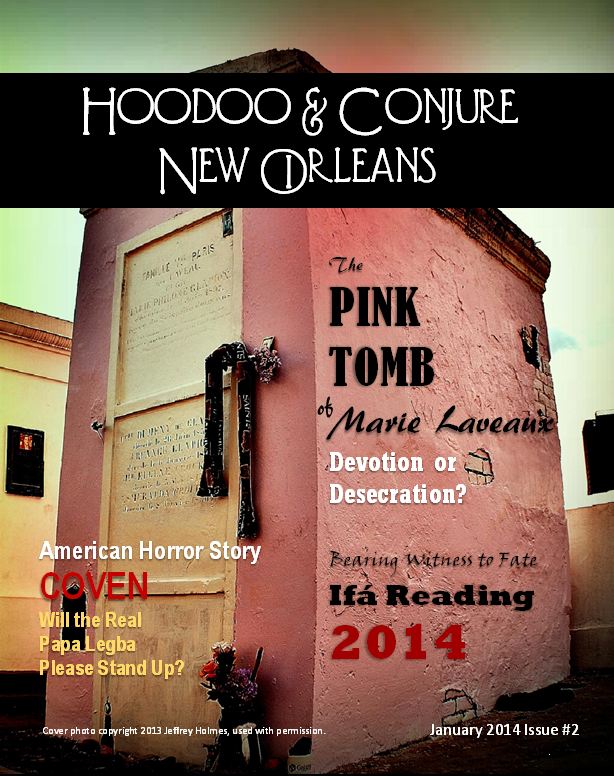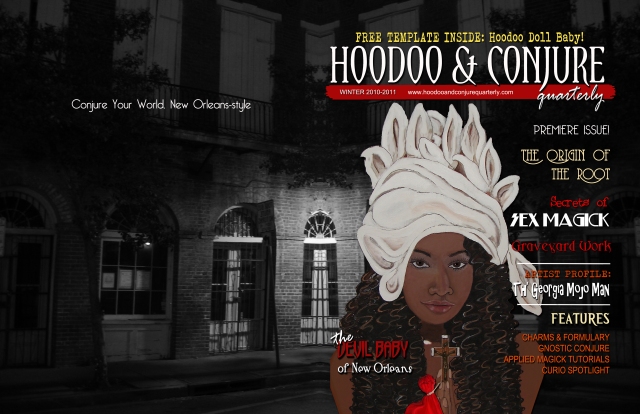
Hoodoo and Conjure New Orleans 2014. Photograph Copyright 2013 Jeffrey Holmes , all rights reserved worldwide.
Only in New Orleans are the Dead given a city in which to reside. Because New Orleans is built on swampland, the Dead cannot be buried in the ground lest they re-surface and float away. Consequently, all but the poor and indigent are laid to rest above ground in elaborate crypts, wall ovens and mausoleums. The decorative ironwork and sculptures adorn the plots, making the cemeteries resemble little cities; hence the nickname, “Cities of the Dead.” The cemeteries in New Orleans attract a lot of visitors each year because of their unique, historic character.
St. Louis Cemetery #1 is the most famous City of the Dead. It is the oldest New Orleans cemetery, constructed to replace the older St. Peter Cemetery as the main burial ground when the city was rebuilt after the Great New Orleans Fire of 1788.
St. Louis Cemetery #1 is also the place where the infamous Voudou Queen Marie Laveaux was laid to rest. This cemetery tends to get the most visitors of all the Cities of the Dead in part because of its architecture and history, and in part because of Voudou. People from all walks of life want a glimpse of Marie Laveaux’s final resting place. Voudou adherents from all over the country make pilgrimages to the gravesite, a testament to its spiritual significance. Most visitors want an opportunity to make a wish at her tomb in hopes that their wishes will be granted by the Voudou Queen. It is said that Marie Laveaux’s grave is the second most visited grave site in the United States, falling second only to Elvis Presley. That’s saying something.
The tomb of Marie Laveaux is more than just a tourist attraction, however; it is at the heart of New Orleans’ sacred geography. It is the place that connects many sacred sites running the gamut from swamps to churches, shrines, cemeteries, Congo Square, St Louis Cathedral, Bayou St John, and every home where someone lights a candle or says a prayer. Just as the cross marks drawn on her tomb mark the place where the world of the physical and the world of the spiritual intersect, her tomb signifies the place where people from all over the world meet and interact with the spirits of the Dead, as well as with the spirit of the Voudou Queen herself.
In December 2013, the tomb that holds the remains of the Mother of New Orleans Voudou was painted a bright pink. Despite the fact that the tomb of the Widow Paris is both a huge tourist attraction and sacred pilgrimage site, it wasn’t until Dorothy Morrison posted a photo of it on Facebook and I wrote an article for the New Orleans Voodoo Examiner that it finally got the local attention it deserved.
After much back and forth about what to do with the Pepto Bismal pink tomb, the Cemeteries Archdiocesan office decided to pressure wash the paint off of the tomb, apparently a standard method of upkeep for cemetery tombs and believed to be the best method to remove the paint. For folks interested in preservation and restoration, however, pressure washing is not the best method and tends to inflict more damage than desired.
Unfortunately, the tomb did suffer some damage as a result of the pressure washing. However, the tomb has been steadily deteriorating for years and remains in dire need of repair. The cost for its restoration is estimated in excess of $10,000.00, so Save Our Cemeteries, The Archdiocese of New Orleans, and the local preservation company Bayou Preservation, LLC have formed a partnership to restore the tomb. Given the cost of repairs, however, it cannot be completed without fundraising efforts. Therefore, they have started a restoration fund that the general public can donate to help fray the expenses. If you would like to donate to the restoration fund, please visit the website and donate what you can. Every little bit helps.
Unfortunately, there isn’t an obvious link to the project on the Save Our Cemeteries website. But you can go to the “Get Involved” tab and then “donate” and make your donation or contact them at (504) 525-3377 or at membership@saveourcemeteries.org.
Read the whole story from the beginning in the latest issue of Hoodoo and Conjure New Orleans 2014.


